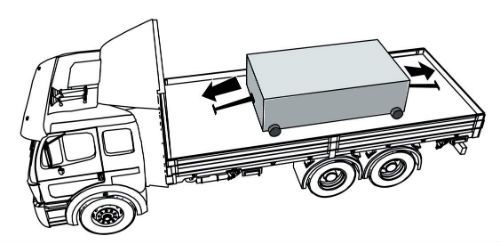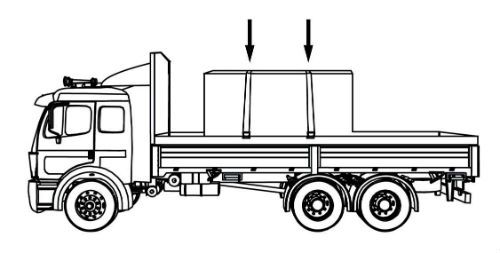CDL Practice Tests: Flatbed Cargo Securement
Choose A Section:
Go!Which of the following can be used as part of the cargo securement system?
- All of these are valid.
- Vehicle structure.
- Securing devices.
- Blocking and bracing equipment.
What is a securement system?

A securement system is a securement method that uses one or a combination of the following elements:
- Vehicle Structure.
- Securing Devices.
- Blocking and Bracing Equipment.
What is the minimum amount of rearward force that a cargo securement system must withstand?
- 50% of cargo weight
- 80% of cargo weight
- 100% of cargo weight
- 20% of cargo weight
Each cargo securement system must be able to withstand a minimum amount of force in each direction.
- Forward Force = 80% of cargo weight when braking while driving straight ahead.
- Rearward Force = 50% of cargo weight when accelerating, shifting gears while climbing a hill, or braking in reverse.
- Sideways Force = 50% of cargo weight when turning, changing lanes, or braking while turning.
-
Upward Force = 20% of cargo weight when traveling over bumps in the road or cresting a hill.
- This requirement is satisfied when the cargo is "Fully Contained."
When securing concrete pipe with a diameter up to 45 inches loaded crosswise as a group,lengthwise tiedowns should be either one 1/2 in chain or wire rope, or:
- Two 1/4 inch chains or wire ropes.
- Two 3/8 inch chains or wire ropes.
- Two nylon straps with aggregate WLL of 50% the weight of the load.
- One 3/8 inch chain or wire rope.
As a group
Place lengthwise tiedowns over the group of pipes:
Either one 13 mm (1/2 in) chain or wire rope,
Or two 10 mm (3/8 in) diameter chain or wire rope
Which of the following is not a reason why loads should be secured?
- Avoid fines and citations
- Prevent damage to the cargo
- Prevent loss of load
- Make it look pretty
Why secure your load? To prevent:
- Loss of life
- Loss of load
- Damage to the cargo
- Damage to the vehicle
- Issuance of citations/fines to driver/carrier
- The vehicle being placed Out-of-Service.
- A crash
When securing building materials, how many tiedowns are required for top tier bundles longer than 5 ft?
- 2
- 1
- 0
- It depends on weight
Tiedowns over the top tier of bundles with a minimum of 2 tiedowns over each top bundle longer than 1.52 m (5 ft).
Which of the following is not an acceptable method of containing loose parts when securing flattened or crushed vehicles?
- Sideboards or sides.
- Suitable covering material.
- Wedge them in between the flattened cars.
- Structural walls.
Containing Loose Parts
Use a containment system that:
- Prevents loose parts from falling from all four sides of the vehicle AND
- Extends to the full height of the cargo.
The containment system can consist of one or a combination of the following methods.
- Structural walls.
- Sides or sideboards.
- Suitable covering material.
The use of synthetic material for containment of loose parts is permitted.
All of these are requirements for securing longwood lengthwise except:
- Secure each log with at least two tiedowns if shorter logs are carried on top of the stack.
- Each outside log should bear against at least two stakes, one near each end of the log.
- Each end of the log should extend at least 3 inches beyond the stakes.
- Must be cradled in two or more bunks or contained by stakes.
Requirements for securing longwood loaded lengthwise
- Longwood must be cradled in two or more bunks or contained by stakes.
- Each outside log should bear against at least two stakes, one near each end of the log.
- Each end of the log should extend at least 0.15 m (6 in) beyond the stakes.
- If shorter logs are carried on top of the stack, secure each log with at least two tiedowns.
When loading and securing a boulder, it should be:
- Placed on symmetrical hardwood blocking that extends 3/4 of the length of the boulder.
- Placed on the vehicle with its largest or flattest side down.
- All of these are requirements.
- Supported on at least 2 pieces of 4in x 4in hardwood blocking, extending the full width of the boulder.
Requirements

Place each boulder on the vehicle with its flattest and/or largest side down.

Support each boulder on at least two pieces of hardwood blocking (at least 10 cm x 10 cm (4 x 4 in) that extend the full width of the boulder.
Place hardwood blocking pieces as symmetrically as possible under the boulder so they support at least 3/4 of the length of the boulder.
'Blocking' is defined as:
- A tapered or wedge-shaped piece used to secure round articles against rolling.
- A rail along the side of a vehicle that protects the side of the vehicle from impacts.
- A structure, device, or another substantial article placed against or around an article to prevent horizontal movement of the article.
- A vertical barrier across the front of the deck of a vehicle to prevent forward movement of cargo.
Blocking:
A structure, device, or another substantial article placed against or around an article to prevent horizontal movement of the article.
How many anchor points should be used to secure an intermodal container on a chassis vehicle?
- 4 latches total, anywhere on the trailer.
- 2 latches in the front and 2 in the middle.
- 2 latches each at or near both the front and rear.
- 2 latches in the middle, and 2 at the rear.
Secure the front and rear of the container independently.
- 2 latches on the chassis engage anchor points towards or at the front of the container.
- 2 latches on the chassis engage anchor points towards or at the rear of the container.
About The Flatbed Cargo Securement CDL Manual
Studying the flatbed cargo securement CDL manual is not a requirement for getting your CDL permit or license. It is required knowledge for flatbed drivers.
Some questions you should be able to answer for flatbed cargo securement:
- What is the minimum Working Load Limit of a tiedown used to secure logs?
- What is the minimum weight of a shipment of paper rolls that would require specific securement requirements?
- When securing concrete pipe over 45 inches loaded crosswise, which direction must the tiedowns on the front half of the load run?
- What is a cab shield?
- When securing concrete pipe over 45 inches loaded crosswise, which direction must the tiedowns on the rear half of the load run?
- What is a dunnage bag?
- Who is responsible for inspecting securing devices and cargo within the first 50 miles?
- How many tiedowns are required on a stack of shortwood loaded crosswise?
- What is the minimum working load limit of each tiedown used to secure crushed or flattened vehicles?
- Define 'bolster'
- What is a hook-lift container?
- When a tiedown is attached directly to the cargo, what is the ideal angle where it attached to the vehicle?
What is a securing device?
Any device specifically manufactured to attach or secure cargo to a vehicle or trailer:
- Synthetic Webbing
- Chain
- Wire rope
- Manila rope
- Synthetic rope
- Steel strapping
- Clamps and latches
- Blocking
- Front-end structure
- Grab hooks
- Binders
- Shackles
- Winches
- Stake pockets
- D-rings
- Webbing ratchet
- Bracing
- Friction mat
What is a tiedown?
A combination of securing devices that forms an assembly that:
- Attaches cargo to, or restrains cargo on a vehicle.
- Is attached to anchor point(s).

Some tiedowns are attached to the cargo and provide direct resistance to restrain the cargo from movement.

Some tie-downs pass over or through the cargo. They create a downward force that increases the effect of friction between the cargo and the deck. This friction restrains the cargo.
 Related Cargo Securement Terms That Every Driver Should Know:
Related Cargo Securement Terms That Every Driver Should Know:
-
Tiedown:
A combination of securing devices which form an assembly that attaches cargo to, or restrains cargo on, a vehicle or trailer, and is attached to anchor point(s).
-
Contained:
Cargo is contained if it fills a sided vehicle, and every article is in contact with or sufficiently close to a wall or other articles so that it cannot shift or tip if those other articles are also unable to shift or tip.
-
Blocking:
A structure, device, or another substantial article placed against or around an article to prevent horizontal movement of the article.
How should tiedowns be attached?
Tiedowns can be used in two ways:
-
Attached to the cargo:
- Tiedowns attached to the vehicle and attached to the cargo.
- Tiedowns attached to the vehicle, pass through or aroundan article of cargo, and then are attached to the vehicle again.
-
Pass over the cargo:
- Tiedowns attached to the vehicle, passed over the cargo, and then attached to the vehicle again.
Tiedown placement:

Place the tiedown as close as possible to the spacer.
Position the tiedowns as symetrically as possible over the length of the article.

Position the tiedowns to preserve the integrity of the article.







 TT On Facebook
TT On Facebook